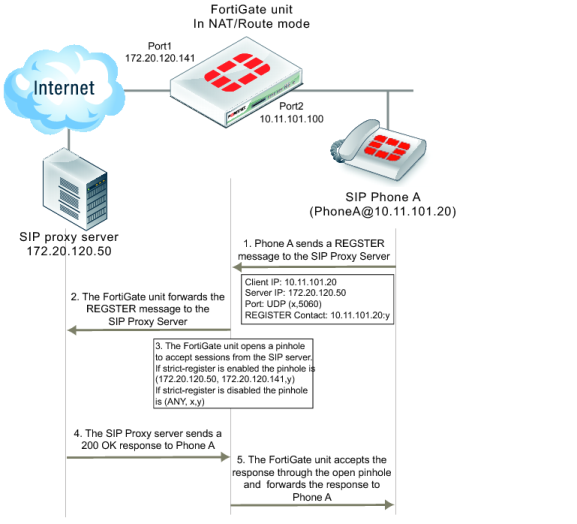Enhancing SIP pinhole security
You can use the strict-register option in a SIP VoIP profile to open smaller pinholes.
As shown in
Figure 304 when FortiGate unit is protecting a SIP server on a private network, the FortiGate unit does not have to open a pinhole for the SIP server to send INVITE requests to a SIP Phone on the Internet after the SIP Phone has registered with the server.
In the example, a client (SIP Phone A) sends a REGISTER request to the SIP server with the following information:
Client IP: 10.31.101.20
Server IP: 10.21.101.50
Port: UDP (x,5060)
REGISTER Contact: 10.31.101.20:y
Where x and y are ports chosen by Phone A.
As soon as the server sends the 200 OK reply it can forward INVITE requests from other SIP phones to SIP Phone A. If the SIP proxy server uses the information in the REGISTER message received from SIP Phone A the INVITE messages sent to Phone A f will only get through the FortiGate unit if an policy has been added to allow the server to send traffic from the private network to the Internet. Or the SIP ALG must open a pinhole to allow traffic from the server to the Internet. In most cases the FortiGate unit is protecting the SIP server so there is no reason not to add a security policy to all the SIP server to send outbound traffic to the Internet.
In a typical SOHO scenario shown in
Figure 305, SIP Phone A is being protected from the Internet by a FortiGate unit. In most cases the FortiGate unit would not allow incoming traffic from the Internet to reach the private network. So the only way that an INVITE request from the SIP server can reach SIP Phone A is if the SIP ALG creates an incoming pinhole. All pinholes have three attributes:
(source address, destination address, destination port)
The more specific a pinhole is the more secure it is because it will accept less traffic. In this situation, the pinhole would be more secure if it only accepted traffic from the SIP server. This is what happens if strict-register is enabled in the VoIP profile that accepts the REGISTER request from Phone A.
(SIP server IP address, client IP address, destination port)
If strict-register is disabled (the default configuration) the pinhole is set up with the following attributes
(ANY IP address, client IP address, destination port)
This pinhole allows connections through the FortiGate unit from ANY source address which is a much bigger and less secure pinhole. In most similar network configurations you should enable strict‑register to improve pinhole security.
Enabling strict-register can cause problems when the SIP registrar and SIP proxy server are separate entities with separate IP addresses.
Enter the following command to enable strict-register in a VoIP profile.
config voip profile
edit Profile_name
config sip
set strict-register enable
end



